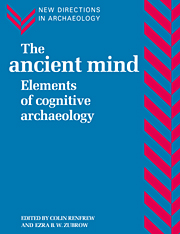Book contents
- Frontmatter
- Contents
- List of figures
- List of tables
- List of contributors
- Preface
- PART I INTRODUCTION
- PART II THE INTERDISCIPLINARY UNDERPINNING
- PART III APPROACHES TO CULT PRACTICE AND TRANSCENDENTAL BELIEF SYSTEMS
- PART IV PREHISTORIC CONCEPTIONS OF SPACE AND TIME
- PART V THE MATERIAL BASIS OF COGNITIVE INFERENCE: TECHNOLOGY
- PART VI THE MATERIAL BASIS OF COGNITIVE INFERENCE: WRITING SYSTEMS
- PART VII CONCLUSION
- Index
Preface
Published online by Cambridge University Press: 03 December 2009
- Frontmatter
- Contents
- List of figures
- List of tables
- List of contributors
- Preface
- PART I INTRODUCTION
- PART II THE INTERDISCIPLINARY UNDERPINNING
- PART III APPROACHES TO CULT PRACTICE AND TRANSCENDENTAL BELIEF SYSTEMS
- PART IV PREHISTORIC CONCEPTIONS OF SPACE AND TIME
- PART V THE MATERIAL BASIS OF COGNITIVE INFERENCE: TECHNOLOGY
- PART VI THE MATERIAL BASIS OF COGNITIVE INFERENCE: WRITING SYSTEMS
- PART VII CONCLUSION
- Index
Summary
One of the most taxing problems in archaeology is to determine about what and in what manner did prehistoric people think. Is it possible to make the ‘mute stones speak’, and will they tell us how (if not what) our predecessors were thinking? A fundamental challenge in archaeology is to develop the theory, methodology and tools to understand prehistoric cognition. It appears that as processual archaeology revolutionized archaeology in the 1960s and 1970s, cognitive archaeology will revolutionize the 1990s and even the early part of the twenty-first century. Cognitive science is still in its childhood and cognitive archaeology is in its infancy. One direction (already followed by some) has been to develop an ‘interpretationist’, anti-scientific literary approach. This view, allied to the relativist philosophy of ‘post-modernism’, has been associated with Hodder, Shanks and Tilley, and Leone. A second, recent approach has been to use a linguistic framework and develop a hermeneutic, semiotic approach. This direction has been espoused by Gardin and Peebles.
However, some workers have sought a rather different direction in prehistoric cognitive research. It is rooted in the scientific tradition and in an empirical methodology. This scientific view of the ancient mind seeks to draw upon the cognitive, and the mathematical and computer sciences. These researchers are beginning to understand which techniques may appropriately be used on archaeological data and how to implement them efficiently.
- Type
- Chapter
- Information
- The Ancient MindElements of Cognitive Archaeology, pp. xiii - xivPublisher: Cambridge University PressPrint publication year: 1994



